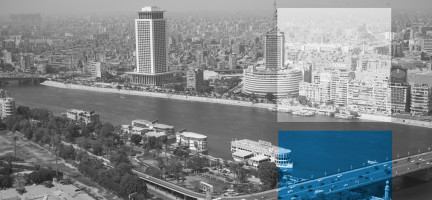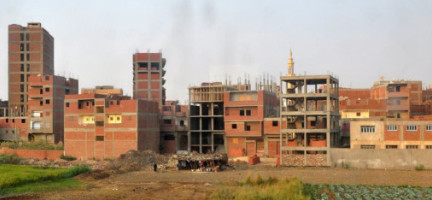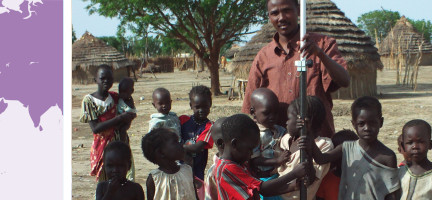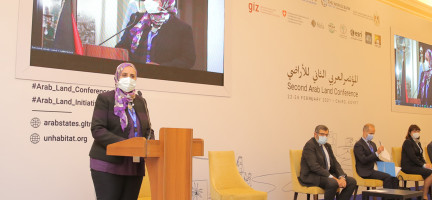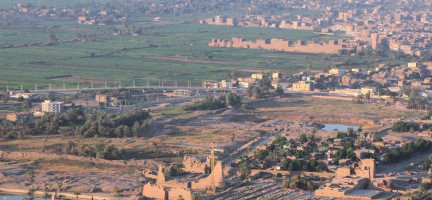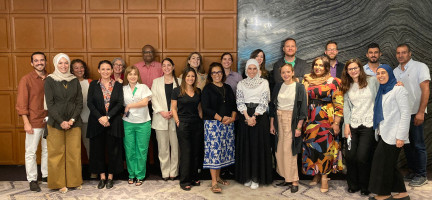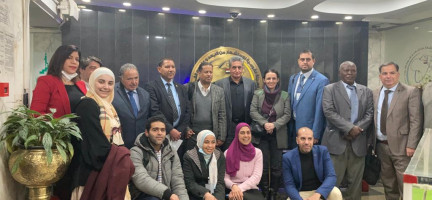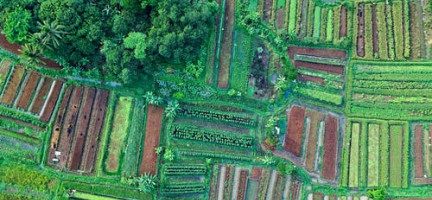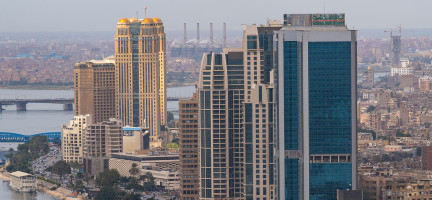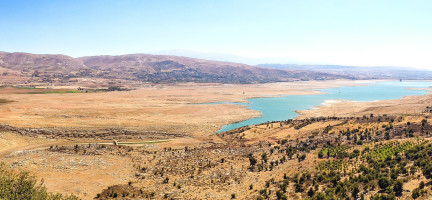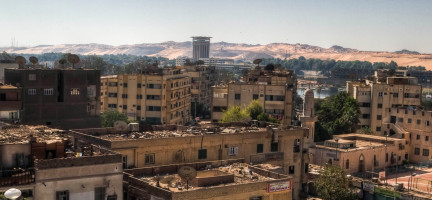Egypt
Egypt is in the northeastern corner of Africa, with the Nile River valley and delta at the heart of the country, Egypt was one of the principal civilizations of the ancient Middle East.
Urbanization is a key driver of development in Egypt, 75 per cent of the GDP is generated in urban areas and 80 per cent of the jobs are in existing cities (NUP Diagnostic report, Unpublished). Urbanization in Egypt increased from 26 per cent in 1937 to 38 per cent in 1960 and 44 per cent in 1986. This percentage fell to around 42.2 per cent in 2017, not because the Egyptian urbanization rate is declining, but rather due to the lack of a clear unified definition of urban-rural areas. In 2021, 43 per cent of Egypt’s total population lived in urban areas and cities.
Furthermore, existing villages and cities, mostly surrounded by valuable agricultural land, are threatened by rapid and unplanned urban growth, and rapid encroachment over agricultural and state-owned land through informal, unplanned urban expansion. There is a considerable number of inhabitants who currently live in unplanned settlements around urban areas. Urban population in Egypt is not evenly distributed among its 255 cities, 96 per cent of the total population lives on 6 per cent of the total national area. [1] This led to more imbalances where 68 per cent of the total population is living in three regions, Greater Cairo Region, Alexandria, and Delta, which represent 1.8 per cent of Egypt’s total area, while 77 cities comprise 4 per cent of the urban population.
The official set of policies that aimed at directing urban expansion focused on the creation of new cities, major land reclamation, and the establishment of major economic and urban development projects. Yet, 95 per cent of the increase in urban population has not been absorbed by these mega projects including the new cities, but rather by the existing agglomerations.
Concerning infrastructure, over 96 per cent of the buildings around Egypt are connected to electricity, slightly above 91 per cent are connected to water, while only 40 per cent of the buildings have access to sanitation. [2] Importantly, there is a considerable difference in terms of accessibility to sanitation between urban and rural areas. While 92 per cent of households in urban areas have access to sanitation, the percentage drops to 31 per cent in rural areas. [3]
Legal and institutional framework
The latest working Egyptian constitution dates 2014. Article 33, concerning housing, land and property rights, states that “The state protects ownership, which is three types: public ownership, private ownership, and cooperative ownership.” However, article 35 protects property owners’ right to pass on their assets to inheritors and safeguards the state’s right to eminent domain "Private property is protected. The right to inherit property is guaranteed. Private property may not be sequestrated except in cases specified by law, and by a court order. Ownership of property may not be confiscated except for the public good and with just compensation that is paid in advance as per the law."
Land administration in Egypt is divided across many government agencies and institutions, mainly but not limited to the Ministry of Housing, Utilities and Urban Communities; Local Development; Agriculture and Land Reclamation; Tourism and Antiquities; Environment; Industry, Trade and Small Industries; Petroleum and Mineral Resources; Tourism; Transportation; Defense; and many other affiliated authorities.
Land tenure
In 1964 the system of registration (Land & Real Estate Ownership Registration Law 1964) was changed from a deed based to a title-based system (segel el `ainee). The application of this law did not materialize immediately, and it was only at the beginning of the 1980s that the title registration system started to operate gradually in registering agricultural land. However, registering is voluntary and initiated by the owner. To date, most agricultural land is registered in a cadastral file with a unique parcel identifier for each property unit but the registry is in large parts outdated which means that in many cases the registered owner dates to the time of first registration in the 19th century. Because informal subdivision was also often not registered, parcel size and shape are different. There were some efforts to pilot the title registration system in urban areas before the 25th of January revolution however, these efforts are currently inactive so the rate of registration in urban areas is extremely low (experts estimate of 5-10 per cent of real estate that is registered).
The main reason for the outdated real estate registry is that the registration process is complicated, time-consuming, and very expensive. The process involves 152 different entities and, depending on the individual case, the owner must follow more than 100 administrative steps which take years and cost several thousand pounds of fees, real estate tax, and bribes. Registering a plot without a building is easier than registering buildings which presume that the building is inside the city boundary, that the seller is the last owner, and that the owner has a building permit - hard to obtain. Also, the procedures, especially in the title registration system, are not clear and many employees apply old laws and regulations complicating the process even more.
Land value
Egypt has a legal framework for land value sharing that dates back to 1955, problems with the design, timing, and administration of the land value sharing instruments are leading to poor results and a lost opportunity to strengthen local public financial capacity (see UN-Habitat 2023, for more information). [4] The enforcement of the instruments is currently very low as the financial benefit of these instruments goes to the general budget at the central level rather than being reinvested in the area of collection. The most relevant land-based finance instruments and their current challenges are described below.
The betterment levy: The Betterment Levy Law 222/1955 stipulates that a charge shall be imposed on all buildings and lands benefiting from an increase in value resulting from public action, such as public infrastructure improvements and plan approval resulting from change in land use or detailed plan approval according to Betterment Levy Law 222/1955, Building Law 119/2008 and the Local Administration Law (Article 51). The rate set in the law is 50 per cent of the increase in value as determined by a committee. Revenues from the tax are considered local revenues (Local Administration Law 43/1979, Article 51, section 5). In practice, the land value increment (betterment levy) is rarely collected in Egypt.
Developer exactions: Building Law 119/2008, Art. 45, allows a city to charge a building permit fee. This fee is determined by the Organization for Construction works, with a maximum amount of EGP 1000. The Governor has the power to increase the fee by 3 per cent each year. Art.51 of the Building Law 119/2008 allows the state to require the contribution of a maximum of 33 per cent of the land for the provision of roads and other public facilities.
Special assessments: Special assessments have been used successfully in Egypt in the context of agricultural improvements such as improved irrigation and drainage. Agricultural Irrigation and Drainage Law No. 12/1984, as amended, provides that when the state undertakes improvements in agricultural infrastructure, those landowners who benefit must repay the cost of construction (plus a 10 per cent administrative fee) in installments over a period of up to 20 years. In addition, if the annual rental value of the affected land is increased as a result of the investment, the increased value will be reflected in the annual agricultural land tax. However, the concept of special assessments is currently not applied in urban areas. Yet, special assessments could be used to engage landowners in financing urban improvements in their direct neighborhood.
The real estate tax: Prior to 2008, the building tax in Egypt generated very little revenue. Most properties were excluded from the base and valuations of the remaining properties were badly out of date. In 2008, the Building Tax law was introduced as part of a larger tax reform agenda. Political opposition at the time prevented the implementation of most parts of the new law. Presidential Decree No. 117 of 2014 amended the law to improve tax collection, increase government revenue, direct new revenue to development projects in local administrative units and discourage land speculation.
Land use
Egypt’s total land area is one million Km2 [5],the vast majority of which is desert. In 2005, agricultural land comprised less than 4 per cent of the total land area. Egypt has almost 35,000 Km2 of arable land and permanent cropland, 100 per cent of which is irrigated. The Nile River Delta and the narrow Nile River Valley comprise virtually all this irrigated land. Yet, at the same time, prime and limited agricultural land in the Nile Valley and Delta is being lost at a rate of nearly 300 Km2 per year due to urbanization. Egypt contains 246 cities, including three with very large populations (Cairo with 21.5 million residents, Alexandria with 12.9 million, and Giza with 9.3 million).
Land development
Existing urban planning tools are not yet appropriate to make land available to match rapid urbanization. Scarcity of developable urban land in the formal sector has led to insufficient land supply and increases in land prices and informal areas. Other factors include lack of detailed urban-planning strategies that account for population growth, absence of clearly established boundaries around villages and cities, and failure to enforce laws that prevent illegal building on agricultural land. A look at the informal areas is also essential in understanding the system of governance over land in Egypt. Through the official lens, many unplanned neighbourhoods are classified as illegal and problematic. While officials often strategize how to extirpate these areas, they also play on citizens’ fears of eviction.
Land dispute resolution
Disputes over rural land are common in Egypt. Frequent causes of disputes include contested land ownership and inheritance claims, contested land boundaries, and issues concerning access to natural resources including water. The Civil Code allows land disputes to be adjudicated by the courts. In addition to formal laws, land disputes are also adjudicated through customary and Islamic law. Possession, ownership, and other real rights in immovable property are regulated by the law of the place in which the immovable property is situated. The rural poor face significant access to justice barriers in Egypt, courts can be costly and timely.
Key interventions
Achieving sustainable urban development project ASUD- Banha pilot project
The main objective of the project is to ensure that the rapid urbanization process is achieved in a controlled and sustainable manner and that the expected socio-economic benefits deriving from this process translate into an equitable and efficient urban settlement pattern. Hereby, the project aims to introduce innovative concepts and tools to explore processes and methodologies for enhanced and more sustainable urban practices. It targets on-the-job learning, institutional capacity building, knowledge services, and transfer as well as the drawing of national policy recommendations based on lessons learned and best practices during the implementation of two pilot interventions, both focusing on city expansions. Moreover, the project supports national and local stakeholders in developing appropriate methodologies for the two types of city expansions currently being applied in the Egyptian context, new cities, and extensions of existing cities.
More specifically, the project aims at (1) documenting and sharing good practices related to the 6 thematic areas, namely: urban planning, urban energy, urban mobility, urban economy, urban land management, urban legislation, and governance; (2) helping cities develop practical, feasible approaches to implementing urban planning, mobility, energy, and economy interventions, and (3) assisting national governments to scale up successful local–level approaches, build the capacities of planning and facilitating institutions, and reflect the resulting lessons in national policies and legislation.
Hayenna Integrated Urban Development Project
The project aims at supporting the Egyptian government’s efforts in sustainably accommodating and planning for the expected increase in population and urbanization rates by offering a context-driven process for managing the urban expansion processes in existing cities and supporting the densification of informal inner-city areas. It intervenes in three components:
Transparent urban planning and design management tackle the implementation of the Building Law (Outcome 1) and seeks to improve different aspects of spatial planning, land management, and how the plans are developed, prepared, and implemented to enable the local government in the pilot governorates to plan and manage inner-city upgrading and urban expansion, and to ground the principles of public participation and inclusion within such processes.
Improved public finance management and land-based financing address challenges related to public finance management, investment planning, and management, in addition to the application of land value capture instruments.
Support for improved urban legislation and regulation focus on enhancing urban legislation and regulations, through documenting lessons learned and best practices from the four pilot sites, as well as the international experience, to inform national-level advocacy that aims to propose action-oriented policies and legal reforms for national level replication.
Strategic National Development Project – National Urban policy
In line with the adoption of the New Urban Agenda, Egypt formulated its National Urban Policy (NUP) which is considered the guiding framework for transforming its urbanization process as a source of wealth by promoting a more compact, socially inclusive, better connected, and integrated cities and clusters which are resilient to climate change and foster sustainable urban development. UN-Habitat, together with the General Organization for Physical Planning (GOPP) as the national counterpart, jointly worked on the NUP formulation process starting from consultation with different stakeholders and experts up until the write-up of the NUP final document. Moreover, the formulation of the Egyptian System of Cities is aiming to help in the decision-making process of what role each city could play and what is needed to enable the city to fulfill this role. The system of cities is regarded as a tool that will enable cities to embark on the road to realize their potential and fulfill their role in the overall country's development. Meanwhile, UN-Habitat is coordinating with GOPP the phase two of the process that will include the implementation, monitoring, and evaluation of the National Urban Policy.
References
[1] UN-Habitat (2023). UN-Habitat Egypt 2023
[2] CAPMAS (2017). Statistical Yearbook 2017.
[3] CAPMAS (2018). Statistical Yearbook 2018.
Disclaimer
The information contained in this page is based on the body of knowledge developed by UN-Habitat, GLTN and the Arab Land Initiative’s partners. The designations employed and the presentation of the material do not imply the expression of any opinion whatsoever on the part of the Secretariat of the United Nations concerning the legal status of any country, territory, city or area, or of its authorities, or concerning delimitation of its frontiers or boundaries, or regarding its economic system or degree of development. The information may contain inaccuracies due to the data source(s) and do not necessarily reflect the views of UN-Habitat or its governing bodies.
The Egypt page is still under construction. Share with us any relevant information, resource or correction to enrich our library. Contact the Arab Land Initiative at unhabitat-arablandinitiative@un.org !



